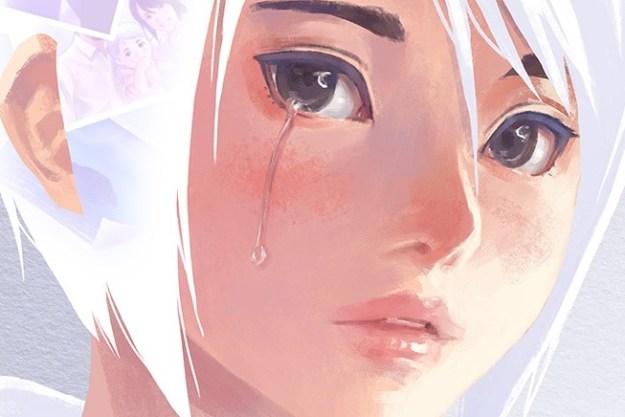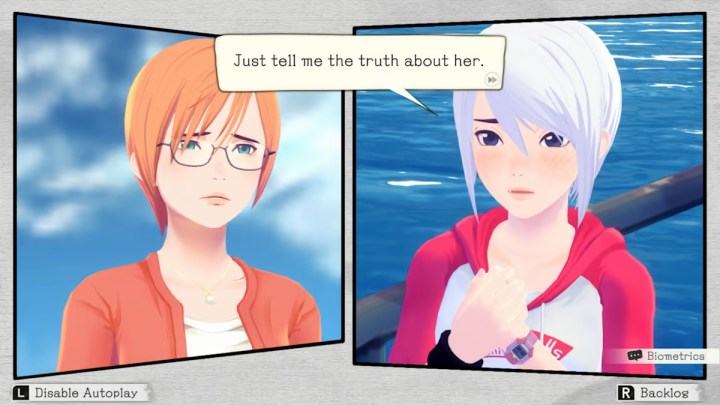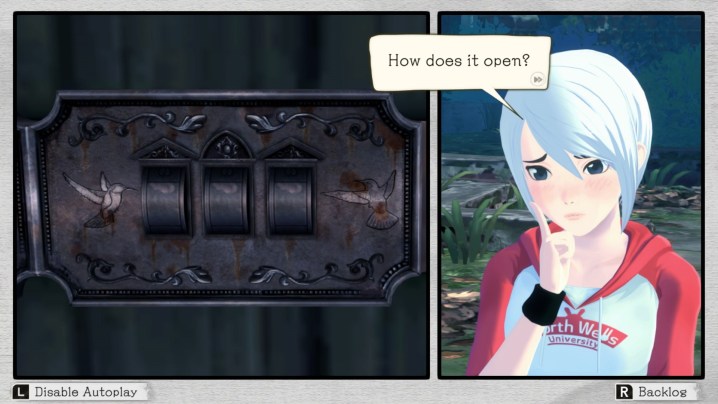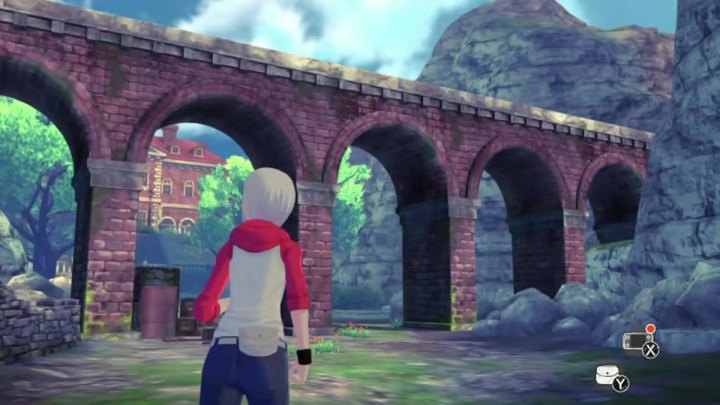
“Another Code: Recollection left me with a lasting impression that's sure to keep my memory of the lost series alive.”
- Beautiful presentation
- Feels like a complete story
- Likeable cast of characters
- Puzzles lack challenge
- Environments vary in quality
“This isn’t what I remember playing on the Nintendo DS as a kid.”
That’s what I found myself saying as I played through the early hours of Another Code: Recollection, a Nintendo Switch remake of two cult classic games. That wasn’t a bad thing. I felt at ease with Recollection and its overhauled visual presentation, whereas the original’s point-and-click format and top-down isometric perspective were unfamiliar and daunting to me as a teenager growing up.
As someone who had trouble playing slightly more complex games like Advance Wars when I was younger, Another Code: Two Memories was just simple enough for me to see through the ending. I remember enjoying my time with it, but that was years ago. Would Recollection replace my childhood memories or respectfully mirror them?
I had a much smoother time with Recollection, although at first, I thought it was only because I now have many more years of gaming experience under my belt. But Nintendo and developer Cing took a different approach to this remake. It’s a much more family-friendly revisit of two great Nintendo games, with new gameplay options and far easier puzzles. While that takes some tension out of the adventure, the collection hits even harder emotionally, thanks to some drastic story overhauls. I can already tell that I’ll remember Recollection more fondly than the originals, keeping the memory of two lost games alive.
Two memories in one
Another Code: Recollection is a Nintendo Switch remake of 2005’s Another Code: Two Memories for the Nintendo DS and its direct sequel, 2009’s Another Code: R — A Journey into Lost Memories for Nintendo Wii. The mystery-filled adventures center around Mizuki Robbins, a young teenage girl who heads to Blood Edward Island on her first journey to find her father. There, she meets a young ghost named D, who has no memory of his past when he was alive. In exchange for trying to recover his memories, he guides Mizuki throughout the Edward mansion to help find her dad.

D’s and Mizuki’s personalities complement each other, as the former provides the latter with the self-confidence to go forward when the current situation looks dire. However, the first adventure, Two Memories, feels more like an extended prologue than a full game; it can be completed in under five hours. It’s a nicely contained story with both D and Mizuki developing as characters by the conclusion, but Mizuki feels incomplete as a character by the end of its sleek runtime.
That’s where the second part, A Journey into Lost Memories, fills the void. Putting both games into one package makes this feel like the definitive way to experience Mizuki’s stories and, as a result, much more complete. This sequel takes place two years after the events of the first game and it greatly expands on Mizuki’s arc. In particular, we learn that Mizuki loves to play guitar, a new, artistic side of her that wasn’t present in the first game.
This time around, Mizuki returns to Lake Juliet to unravel the mystery surrounding her mother. A Journey into Lost Memories is almost twice as long as the first game and, as a result, has much more downtime. When the stakes aren’t as high early in the game, it smartly uses its calmer moments to let Mizuki interact with the supporting cast of characters.
It leaves much more of an emotional impact.
For example, Mizuki initially doesn’t get along with the spoiled rich girl Elizabeth Alfred. However, they come to learn that they have a lot of things in common, such as their shared love for music. Elizabeth is also a singer, and they’re both pining for their mothers’ love. These tender moments make Mizuki feel like a much more fully developed character than she was in the first game.
Two Memories felt like an almost 1:1 story remake of the original, whereas A Journey into Lost Memories has undergone extensive change. Without going into spoilers, the rewrites of certain characters and story elements serve its themes of loss and grief better than the original Wii game did — it leaves much more of an emotional impact.
New puzzles for a new age
Recollection’s gameplay revolves around exploration that has players looking for clues to solve puzzles. Those can be as simple as putting a group of dolls in the correct order or matching certain symbols together on doors. As a guiding gameplay system, the puzzles provide just enough engagement to what would otherwise be a straightforward narrative game or visual novel.
The biggest issue with Recollection is that the puzzles aren’t really challenging. While they don’t necessarily insult your intelligence like the ones in Detective Pikachu Returns, I sometimes wonder if some of them are there to just intrude on my story progress, as many of them are quite easy. It really hammers home Recollection’s more family-friendly direction.

Recollection also has new gameplay options that straight-up tell players the answers to puzzles. Additionally, there’s an option to show a direction marker that says exactly what object or area needs to be interacted with next to progress. Thankfully, players can toggle these on and off if they don’t want their hand held any more than it already is. Despite being let down by the lack of challenge, I found these options incredibly helpful as I wound up prioritizing the story over the puzzle-solving. New options help remove any friction for those who simply want to enjoy the superior visual novel side of the games.
A new canvas
Whereas the first game on the DS used a top-down isometric view and the second game on Wii utilized 3D character models moving around on a 2D plane. Recollection completely replaces those with a third-person perspective, like you’d see in games such as Life is Strange. It mostly works, though not without a few messy transitions; I found that the camera is too close to Mizuki’s back, making moving around a little frustrating.

However, this radical shift helps modernize Recollection’s presentation. The Edward Mansion and surrounding areas around Lake Juliet looked flat in their original games. While this has been somewhat improved, the environments still look dull compared to the bright character models. Even so, Recollection’s 360-degree exploration amplifies the Edward Mansion’s emptiness and Lake Juliet’s serenity. During the former, I felt like I was going through a much more family-friendly version of the creepy Spencer Mansion from Resident Evil.
The characters also look fantastic with their gorgeous cel-shaded art style. Their expressiveness really adds life and emotional weight to the story. The 2D art doesn’t lag either, as the watercolor style of the character portraits looks just as great as the 3D cel-shaded models. Recollection also adds full voice acting, whereas the originals didn’t have any. That creates a whole new layer of storytelling and immersion that wasn’t there before.
If it winds up being a eulogy for a neglected series, then I’m at peace with the collection as a send-off.
Another Code: Recollection left me with a lasting impression that’s sure to keep my memory of the original games alive, even if the new release doesn’t precisely mirror the originals. That’s a fitting way to leave them, considering that Recollection’s grand takeaway is that even when someone is physically gone, our memories of them can still keep them alive. Sure, it’s an exaggeration to say that the original DS and Wii versions are truly dead, but they’re somewhat inaccessible, considering they require dated hardware. Recollection honors the series, making impactful changes without totally overwriting my dear memories of the originals. If it winds up being a eulogy for a neglected series, then I’m at peace with the collection as a send-off. But I hope that I can create some new memories with Mizuki in the future.
Another Code: Recollection was tested on Nintendo Switch.



